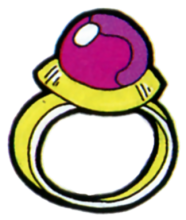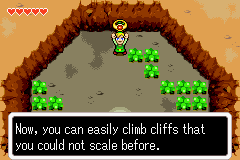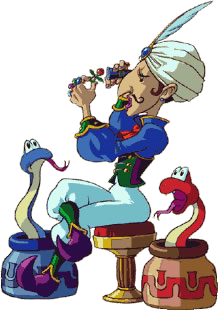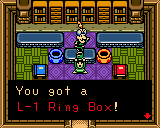Gossip Stone: Should the Magic Rings make a return to the series?
Posted on September 26 2014 by Thomas Jacobs
 Rings make for handy magic items: they’re small, lightweight and are easy to carry in addition to your other magical gear. Finding magic rings in the Zelda games is always useful to either continue in the game, make Link tough enough to more easily survive the later dungeons or even give him a variety of bonuses. But they have only appeared in 2D games, with the last time being The Minish Cap. Perhaps it is time for them to make their return? Read more after the break!
Rings make for handy magic items: they’re small, lightweight and are easy to carry in addition to your other magical gear. Finding magic rings in the Zelda games is always useful to either continue in the game, make Link tough enough to more easily survive the later dungeons or even give him a variety of bonuses. But they have only appeared in 2D games, with the last time being The Minish Cap. Perhaps it is time for them to make their return? Read more after the break!
The first time magic rings appear in the series is in the very first game. The Blue Ring and the Red Ring reduce all damage done to Link to one half and one quarter, respectively, of the damage dealt to him. This is quite useful given the high difficulty level of the game and makes Link all the more durable as he tracks down the pieces of the Triforce of Wisdom. The Blue Ring can be found at any time only seven screens from Link’s starting position, though it costs a hefty 250 rupees (out of the game’s max of 255). The Red Ring can be found in the very last dungeon, where it serves as the treasure alongside the Silver Arrows. The rings also change the color of Link’s tunic; the Blue Ring turns it blue and the Red Ring turns it red. They also change the color of Princess Zelda’s dress for what is likely to be technical limitations. This effect was repeated in the original version of Ocarina of Time, where the color of Link’s tunic changes the color of the clothes and lipstick of Nabooru’s second-in-command, whom you meet in the Gerudo Fortress.
 In The Minish Cap Link can buy the Grip Ring for a modest 40 rupees from a Business Scrub. This is a key plot item used to scale Crenel Mountain and get to the Cave of Flames, the game’s second dungeon. The Grip Ring is also used to scale certain parts of Veil Falls and get to the entrance of the Cloud Tops and the game’s fourth dungeon. Here Link will also find Biggoron who can upgrade his shield into the Mirror Shield after you complete the game, which he strangely enough does by chewing on it.
In The Minish Cap Link can buy the Grip Ring for a modest 40 rupees from a Business Scrub. This is a key plot item used to scale Crenel Mountain and get to the Cave of Flames, the game’s second dungeon. The Grip Ring is also used to scale certain parts of Veil Falls and get to the entrance of the Cloud Tops and the game’s fourth dungeon. Here Link will also find Biggoron who can upgrade his shield into the Mirror Shield after you complete the game, which he strangely enough does by chewing on it.
But when you mention rings in a Zelda game, thoughts will quickly go towards the Oracle games and its many rings that provide a variety of power-ups for Link. These rings could be bought or found in difficult-to-find treasure chests and brought to the jeweler Vasu for appraisal for 20 Rupees. If it’s a new one then Link can wear it; if not then the ring was bought by the jeweler for 30 Rupees. There are 64 rings in total but you can’t get all of them in one game. If you want the full 64 rings you have to not only play both games but also play them on a GameBoy Advance. Even worse, the rings that you get this way do not have any effects and serve only as bragging rights. For example, wearing the ring that you got from defeating Ganon, playing the games on a GBA, collecting 10,000 Rupees or breaking 100 signs have no effect whatsoever. And while you can trade rings between games using the GameBoy Color, this ONLY works for the Color and not for the Advance because of how the trading was programmed. Rings are equipped from the Ring Box, which comes in two levels (level 1 allows for one ring and level 2 for three), at the Jeweler, and Link can have up to three rings in his inventory at the same time. These can be equipped and swapped freely, but for access to his other rings he has to go visit Vasu again.
 The rings themselves can do a variety of things. A good chunk of them are about Link’s sword damage and the damage he takes: Power Rings allow him to deal more damage, but he takes more, while the Armor Rings boost defense. The Red Ring and the Blue Ring return but their effects are in line with the effects of the tunics of the Color Dungeon of Link’s Awakening. There is also an in-between in the shape of the Green Ring, which has half the effect of both the Red Ring and the Blue Ring. Certain other rings add to Link’s swordplay as well, and allow him to charge his spin attack faster, spin twice, be unaffected by the Bubble enemies, allow the sword beam even when not at full health, replace his spin attack with a sword beam, and more. Other rings improve his boomerang or bombs, protect him against a variety of types of damage (from falling into pits to spiked floors to becoming immune to electrical attacks), and lots of other tricks. Still other rings change Link’s interactions with the environment by making him immune to quicksand that moves him around, floors that break when he stands on them, and swimming becomes a lot easier. Finally, there are the gimmick rings that have little use in a regular play-through but have fun effects. For example, there are rings that turn Link into a Like Like, Octo, Moblin or even a sprite that looks like it came from the original Legend of Zelda game. There are also rings that allow Link to punch enemies instead of using his sword to give the game more of a challenge, and one that halves all damage Link does but doubles all he takes, making the game significantly harder.
The rings themselves can do a variety of things. A good chunk of them are about Link’s sword damage and the damage he takes: Power Rings allow him to deal more damage, but he takes more, while the Armor Rings boost defense. The Red Ring and the Blue Ring return but their effects are in line with the effects of the tunics of the Color Dungeon of Link’s Awakening. There is also an in-between in the shape of the Green Ring, which has half the effect of both the Red Ring and the Blue Ring. Certain other rings add to Link’s swordplay as well, and allow him to charge his spin attack faster, spin twice, be unaffected by the Bubble enemies, allow the sword beam even when not at full health, replace his spin attack with a sword beam, and more. Other rings improve his boomerang or bombs, protect him against a variety of types of damage (from falling into pits to spiked floors to becoming immune to electrical attacks), and lots of other tricks. Still other rings change Link’s interactions with the environment by making him immune to quicksand that moves him around, floors that break when he stands on them, and swimming becomes a lot easier. Finally, there are the gimmick rings that have little use in a regular play-through but have fun effects. For example, there are rings that turn Link into a Like Like, Octo, Moblin or even a sprite that looks like it came from the original Legend of Zelda game. There are also rings that allow Link to punch enemies instead of using his sword to give the game more of a challenge, and one that halves all damage Link does but doubles all he takes, making the game significantly harder.
While the rings added to the games quite a bit, they were not without flaws. Some of the rings are found in specific places in every game, but the rings that are not in fixed locations have rarity tiers appointed to them, affecting where they can be found. Rings of up to tier 3 can be found commonly from enemies, patches for the Gasha Seeds that Link can plant or encounters with the witch, Maple. Rings of tier four and onward, however, are very rare and can only be found in specific patches of soil for the Gasha Seeds and with plenty of luck, making collecting all of the rings a very long chance-based mission. Additionally, the Gasha Seeds can be found in the game in only a limited supply; getting more requires Link to buy them for a hefty 300 rupees per piece, without any guarantee of success. And, as stated before, some of the rings are limited to certain games (for example, you cannot get Power Ring 3 in a game of Oracle of Ages), and getting some of the rings is not possible in games not run on a GBA (this unfortunately includes the 3DS Virtual Console version of the games).
 If the rings are to return, this can be done in a few different ways. First would be to wholesale copy the formula from the Oracle games. Some of the rings can only be obtained as a matter of chance, and the others are hidden all over the game world. Another option would be to have all rings appear in fixed locations, such as treasure chests, in monster drops or as prizes from mini-games. A more extreme option would be to make them an important gameplay/plot element like Majora’s Mask did with masks. There are lots of them to be found in the game, and several of them are key plot items. If you collect them all you get something awesome at the end of the game. The difficulty with this, compared to the masks, is that rings are less visible on Link as he goes around adventuring, and even when the effects they have are very visible they lack the presence that the masks have.
If the rings are to return, this can be done in a few different ways. First would be to wholesale copy the formula from the Oracle games. Some of the rings can only be obtained as a matter of chance, and the others are hidden all over the game world. Another option would be to have all rings appear in fixed locations, such as treasure chests, in monster drops or as prizes from mini-games. A more extreme option would be to make them an important gameplay/plot element like Majora’s Mask did with masks. There are lots of them to be found in the game, and several of them are key plot items. If you collect them all you get something awesome at the end of the game. The difficulty with this, compared to the masks, is that rings are less visible on Link as he goes around adventuring, and even when the effects they have are very visible they lack the presence that the masks have.
Anothing thing to look at is how to equip them. In the Oracle games it was kind of a hassle to get to Vasu, have him appraise the rings you fond and store the ones that weren’t currently used. To solve this the rings could come appraised as you discover them and have Link carry them all on him at the same time. There is also the issue of how many rings Link can wear at the same time: while the Oracle games allowed only, it is not impossible to equip two or perhaps even more rings, though wearing too many would be a bit silly.
Should the rings make their return? If so, should they return as simple power-ups or something more plot-related, and what kinds of effects should they have? Or are they a relic from an earlier game and are best left where they are? Let us know in the comments!



